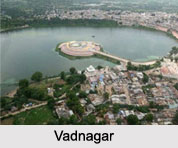 Vadnagar is considered as the ancient city in west India. It is now a city in Mehsana district in Gujarat. This city in west India has many Hindu temples. In Indian Scripts, this city is named as Anartpur.
Vadnagar is considered as the ancient city in west India. It is now a city in Mehsana district in Gujarat. This city in west India has many Hindu temples. In Indian Scripts, this city is named as Anartpur.
Location of Vadnagar
Vadnagar is now a major commercial city located at an average elevation of 143 metres from the sea level.
History of Vadnagar
History of Vadnagar dates back from the time of Mahabharata. It was the part of Anarta kingdom. The inscription defines the rule of Western Satraps of Saurashtra, King Rudradaman I in Vadnagar and its adjacent parts. Harsola Copper Plates also define the rule of early Indian rulers in Vadnagar.
Geography of Vadnagar
 The latitudinal and longitudinal limit of Vadnagar is about 23.78 degree north to 72.63 degree east. The average elevation of Vadnagar is about 143 meters (469 feet).
The latitudinal and longitudinal limit of Vadnagar is about 23.78 degree north to 72.63 degree east. The average elevation of Vadnagar is about 143 meters (469 feet).
Demography of Vadnagar
According to the Population census in the year 2011, Vadnagar had a population of 25,041. The males constitute 51 percent of the population and females 49 percent. The average literacy rate of Vadnagar is about 65 percent. The male literacy rate is 75 percent, and female literacy is 54 percent. In Vadnagar, 13 percent of the population is under 6 years of age.
Tourism in Vadnagar
Tourism in Vadnagar includes a number of Hindu temples which are dedicated to Mahadeva, Chhabila, Lord Hanuman, Ashapuri Mata, Ambaji Mata, Vishnupuri and Gaurikund. There is an important temple of 15th century is "Hatkeswar Mahadev temple". It is the family deity of the Brahmin. Facing the east, this temple is well known for its architecture. This temple is surrounded with high walls, surmounted with three large circular domes. The roof of the sanctum then rises to the pinnacle which stations one of the ancient Shiva lingam of ancient India. The exterior of the temple is well decorated with the fine figures of the nine planets and Purana deities, the chief gods of the Hindu pantheon and the scenes from the life of Lord Krishna and Pandava princes. Sitala Mata Temple is another important temple. It was ornately carved with fine figures of celestial beings and it is one of the well decorated temples of Gujarat. The doorframe and ceiling is decorated with the sculptures of Rasalila of Krishna which is most artistic piece of Vadnagar. The place also includes two magnificent Kriti Stambas which are built with red sandstone in identical shape and size. The pillars and arches are decorated with floral designs like leaves, creepers, lotus, animal motifs and human figures which are engaged in various activities and divine figures in different poses. Along with the images of Lord Ganesha and Lord Kartikeya these are some of the well built Hindu deity temples.



















